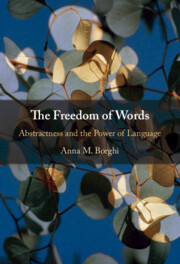Book contents
- The Freedom of Words
- The Freedom of Words
- Copyright page
- Dedication
- Contents
- Figures
- Acknowledgments
- Introduction
- Part I Language and Its Power
- Chapter 1 Language as a Physical Tool
- Chapter 2 Language as an Inner/Cognitive Tool
- Chapter 3 Language as a Social Tool
- Chapter 4 Evolving Language in Interaction
- Part II Abstractness and Language
- Index
- References
Chapter 1 - Language as a Physical Tool
from Part I - Language and Its Power
Published online by Cambridge University Press: 20 July 2023
- The Freedom of Words
- The Freedom of Words
- Copyright page
- Dedication
- Contents
- Figures
- Acknowledgments
- Introduction
- Part I Language and Its Power
- Chapter 1 Language as a Physical Tool
- Chapter 2 Language as an Inner/Cognitive Tool
- Chapter 3 Language as a Social Tool
- Chapter 4 Evolving Language in Interaction
- Part II Abstractness and Language
- Index
- References
Summary
This chapter shows that language works as a physical tool by impacting how we perceive our body (interoception) and how we perceive and interact with the external world (perception and action). First, I contend that language might help us detect bodily inner signals and states . Then, I show that language recruits object affordances, the opportunities to act objects offer us, but that it does so in its own distinctive way. Language exploits previously originated structures and mechanisms, those of the motor system, but uses them flexibly. Consistent with this, I show that language shapes perception and object manipulation, extends the space we perceive as near, and modulates our perception of objects in space. Finally, using an example of the concept of color, I suggest that not only the faculty of language but also the different languages we use, through spoken words or signs, shape our world differently.
Keywords
- Type
- Chapter
- Information
- The Freedom of WordsAbstractness and the Power of Language, pp. 15 - 51Publisher: Cambridge University PressPrint publication year: 2023



